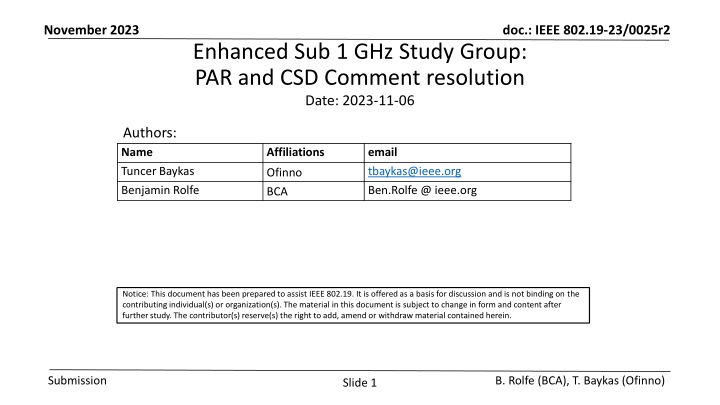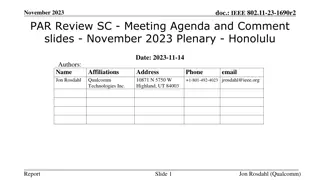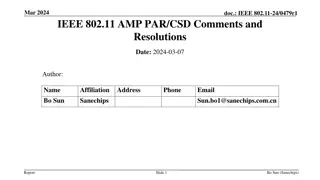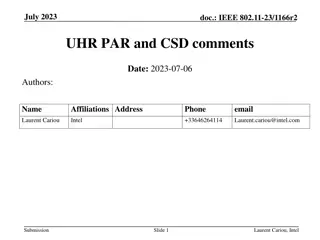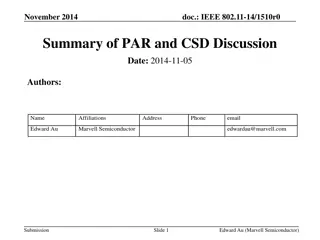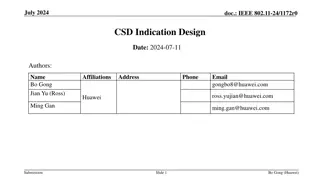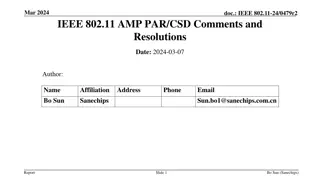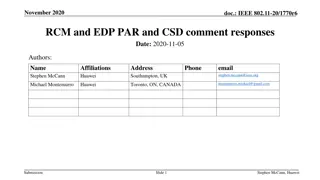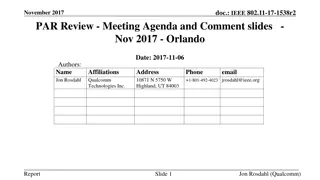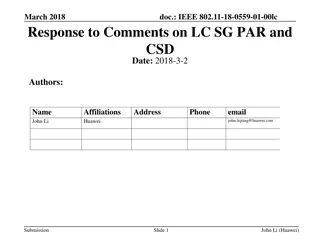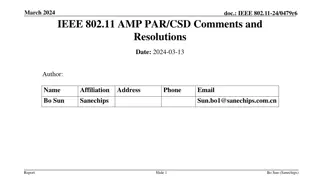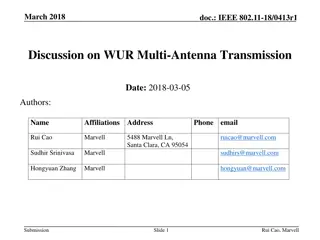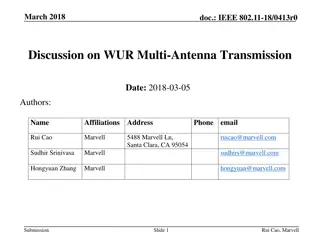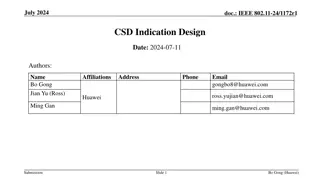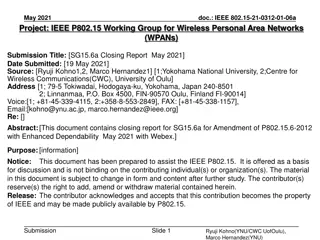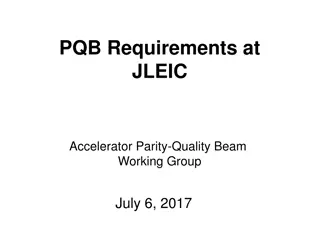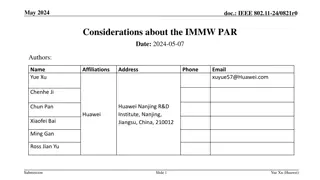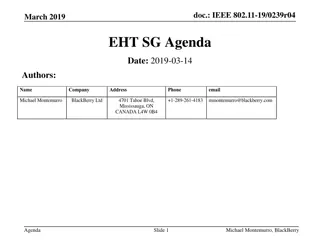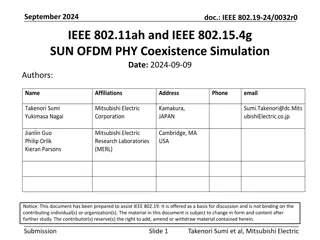IEEE 802.19-23/0025r2 Enhanced Sub-1GHz Study Group PAR and CSD Comments Resolution
This document discusses the resolution of comments on the PAR and CSD from various IEEE 802 groups related to the Enhanced Sub-1GHz Study Group. It presents comments received and proposes resolutions, focusing on coexistence recommendations, updates for new market requirements, and device density considerations. The recommendations aim to address spectrum sharing below 1GHz among IEEE Std 802.11-2020 and IEEE Std 802.15.4 devices, emphasizing improved coexistence and system implementation. The document highlights suggested amendments, scope enhancements, and submission timelines.
Download Presentation

Please find below an Image/Link to download the presentation.
The content on the website is provided AS IS for your information and personal use only. It may not be sold, licensed, or shared on other websites without obtaining consent from the author.If you encounter any issues during the download, it is possible that the publisher has removed the file from their server.
You are allowed to download the files provided on this website for personal or commercial use, subject to the condition that they are used lawfully. All files are the property of their respective owners.
The content on the website is provided AS IS for your information and personal use only. It may not be sold, licensed, or shared on other websites without obtaining consent from the author.
E N D
Presentation Transcript
November 2023 doc.: IEEE 802.19-23/0025r2 Enhanced Sub 1 GHz Study Group: PAR and CSD Comment resolution Date: 2023-11-06 Authors: Name Tuncer Baykas Benjamin Rolfe Affiliations email tbaykas@ieee.org Ben.Rolfe @ ieee.org Ofinno BCA Notice: This document has been prepared to assist IEEE 802.19. It is offered as a basis for discussion and is not binding on the contributing individual(s) or organization(s). The material in this document is subject to change in form and content after further study. The contributor(s) reserve(s) the right to add, amend or withdraw material contained herein. Submission B. Rolfe (BCA), T. Baykas (Ofinno) Slide 1
doc.: IEEE 802.19-23/0025r2 November 2023 PAR and CSD Comment Review and Resolution Objective: Review and resolve comments received on the PAR and CSD Comments received from: 802.11 802.15 802.3 802.1 This document presents the comments received and proposes resolutions for each Submission B. Rolfe (BCA), T. Baykas (Ofinno) Slide 2
doc.: IEEE 802.19-23/0025r2 November 2023 802.11 Comments Submission B. Rolfe (BCA), T. Baykas (Ofinno) Slide 3
doc.: IEEE 802.19-23/0025r2 November 2023 5. 802.19.3a - Recommended Practice Amendment: Enhanced sub-1GHz Coexistence , PAR and CSD 2.1 Title Change Amendment: Additional recommendations for improved coexistence to Amendment: Additional recommendations for improving coexistence Recommended Resolution: Accept 4.3 Missing date for submission to RevCom. Recommended Resolution: Revised, add date expected to submit to REVCOM 12 months after first SA ballot. 5.2.a Scope of the complete standard: replace with This recommended practice provides guidance on the implementation, configuration, and commissioning of systems sharing spectrum in frequencies below 1 GHz. It addresses the IEEE Std 802.11-2020 sub 1 GHz (S1G) physical layer (PHY), the IEEE Std 802.15.4 smart utility networking (SUN) frequency shift keying (FSK) PHY, and the IEEE Std 802.15.4 SUN Orthogonal Frequency Division Multiplexing (OFDM) PHY. Recommended Resolution: Accept Submission B. Rolfe (BCA), T. Baykas (Ofinno) Jon Rosdahl (Qualcomm) Slide 4 Slide 4
doc.: IEEE 802.19-23/0025r2 November 2023 5. 802.19.3a - Recommended Practice Amendment: Enhanced sub- 1GHz Coexistence , PAR and CSD (2) 5.2.b: change to This amendment updates and expands coexistence recommendations to address new market requirements, increasing data traffic, greater device density of devices, and increased potential for congestion based on both IEEE Std 802.11-2020 and IEEE Std 802.15.4 Sub-1 GHz standards. This project includes recommendations with respect to new devices, as well as compatibility with deployed legacy devices. Recommended Resolution: Accept Submission B. Rolfe (BCA), T. Baykas (Ofinno) Jon Rosdahl (Qualcomm) Slide 5 Slide 5
doc.: IEEE 802.19-23/0025r2 November 2023 5. 802.19.3a - Recommended Practice Amendment: Enhanced sub-1GHz Coexistence , PAR and CSD (3) 5.5 Need for the Project: Suggested replacement: Since publication of the initial recommended practice, both underlying standards and market requirements have changed. These changes and spectrum regulation changes have resulted in new requirements driving new solutions which use both IEEE Std 802.11 Sub-1 GHz (S1G) and IEEE Std 802.15.4 S1G standards. There are many millions of deployed legacy 802.15.4 S1G devices (commonly referred to as IEEE Std 802.15.4g in the industry). Devices based on IEEE Std 802.11 S1G (commonly referred to as IEEE Std 802.11ah in the industry) are expected to begin widespread deployment. The need for new devices using different technologies to coexist is critical to support and sustain growth in the markets. Recommended Resolution: Accept Submission B. Rolfe (BCA), T. Baykas (Ofinno) Jon Rosdahl (Qualcomm) Slide 6 Slide 6
doc.: IEEE 802.19-23/0025r2 November 2023 5. 802.19.3a - Recommended Practice Amendment: Enhanced sub- 1GHz Coexistence , PAR and CSD (3) 8.1 Additional Explanatory Notes: Must include full names of all standards cited. Suggest replace with the following: 8.1 Additional Explanatory Notes: 5.2a, 5.2b, 5.5: IEEE Std 802.11-2020: IEEE Standard for Information Technology Telecommunications and Information Exchange between Systems Local and Metropolitan Area Networks Specific Requirements Part 11: Wireless LAN Medium Access Control (MAC) and Physical Layer (PHY) Specifications IEEE Std 802.15-2020: IEEE Standard for Low-Rate Wireless Networks Recommended Resolution: Revised: As proposed but add missing .4 : IEEE Std 802.15.4-2020: IEEE Standard for Low-Rate Wireless Networks Submission B. Rolfe (BCA), T. Baykas (Ofinno) Jon Rosdahl (Qualcomm) Slide 7 Slide 7
doc.: IEEE 802.19-23/0025r2 November 2023 5. 802.19.3a - Recommended Practice Amendment: Enhanced sub- 1GHz Coexistence , PAR and CSD (4) CSD 1.1.1 Change defined in the 802.11 and 802.15.4 standards. to defined in IEEE Std 802.11 and IEEE Std 802.15.4 standards Recommended Resolution: Accept CSD 1.2.1 change on uses of to on the use of Change 802.1 to 802.11 Make Sub-1 GHz format i.e. capitalization and spaces consistent. Throughout the CSD and PAR. Recommended Resolution: Accept Submission B. Rolfe (BCA), T. Baykas (Ofinno) Jon Rosdahl (Qualcomm) Slide 8 Slide 8
doc.: IEEE 802.19-23/0025r2 November 2023 Comments from 802.3 Submission B. Rolfe (BCA), T. Baykas (Ofinno) Slide 9
doc.: IEEE 802.19-23/0025r2 November 2023 Comments from 802.3 IEEE P802.19.3a - Recommended Practice Amendment: Enhanced sub-1GHz Coexistence PAR item 4.3: No date provided for RevCom submittal. Recommended Resolution: Revised, add date expected to submit to REVCOM 12 months following initial SA ballot Submission B. Rolfe (BCA), T. Baykas (Ofinno) Slide 10
doc.: IEEE 802.19-23/0025r2 November 2023 Comments from 802.3 PAR item 5.5: It is not clear what the sentence 'Also experience within the industry can be used to update recompensates.' is trying to say. Recommended Resolution: Revised, Replace with text suggested in 802.11 comment (5.5): Since publication of the initial recommended practice, both underlying standards and market requirements have changed. These changes and spectrum regulation changes have resulted in new requirements driving new solutions which use both IEEE Std 802.11 Sub-1 GHz (S1G) and IEEE Std 802.15.4 S1G standards. There are many millions of deployed legacy 802.15.4 S1G devices (commonly referred to as 802.15.4g in the industry). Devices based on IEEE Std 802.11 S1G (commonly referred to as 802.11ah in the industry) are expected to begin widespread deployment. The need for new devices using different technologies to coexist is critical to support and sustain growth in the markets. Submission B. Rolfe (BCA), T. Baykas (Ofinno) Slide 11
doc.: IEEE 802.19-23/0025r2 November 2023 Comments from 802.15 Submission B. Rolfe (BCA), T. Baykas (Ofinno) Slide 12
doc.: IEEE 802.19-23/0025r2 PAR and CSD Review by 802.15 SCM 802.19 PARs and CSDs 802.19.3a - Recommended Practice Amendment: Enhanced sub-1GHz Coexistence , PAR and CSD PAR Comments 4.3: please include a Project completion date Recommended Resolution: Accept 5.2b: sub-1GHz should be sub-1 GHz Recommended Resolution: Revised, use Sub-1 GHz consistently. Submission B. Rolfe (BCA), T. Baykas (Ofinno) Slide 13
doc.: IEEE 802.19-23/0025r2 PAR and CSD Review by 802.15 SCM 802.19 PARs and CSDs 5.3: Please use consistent language for highlighted parts below: Changes in the markets and rules changes have resulted in new requirements that are driving new solutions which will use both IEEE Std 802.11 Sub-1 Giga Hertz (S1G) and IEEE Std 802.15.4 S1G standards. New requirements include need to support increased data traffic per device, many more devices per unit area and a corresponding increase in congestion potential. There are many millions of deployed legacy 802.15.4 S1G devices (commonly referred to as 802.15.4g in the industry). Devices based on IEEE Std 802.11 S1G (commonly referred to as 802.11ah in the industry) are expected to begin widespread deployment. The need for new devices using different technologies to coexist with each other and the deployed base of legacy devices is critical to support and sustain growth in the markets. Changes in IEEE Std 802.15.4 and IEEE Std 802.11 include new features that can be used to enhance coexistence. This project will add new recommendations and update existing recommendations incorporating new and expanded features of both standards. Also experience within the industry can be used to update recompensates. The limited amount of spectrum available in S1G bands drives an increasing need to share the spectrum efficiency. This project will enhance the ability of users of this standard to address ongoing and growing coexistence challenges. This recommended practice enables IEEE Std 802.15.4 and IEEE Std 802.11ah-2016 to most effectively operate in license exempt Sub-1 GHz frequency bands, by providing best practices and coexistence methods. This recommended practice uses existing features of the referenced standards and provides guidance to implementers and users of IEEE 802(R) wireless standards. (see next slide) Submission B. Rolfe (BCA), T. Baykas (Ofinno) Slide 14
doc.: IEEE 802.19-23/0025r2 PAR and CSD Review by 802.15 SCM 802.19 PARs and CSDs Recommended Resolution: Revised. Note the comment is text in section 5.5 (need for the project). The text of 5.5 has been replaced with: Since publication of the initial recommended practice, both underlying standards and market requirements have changed. These changes and spectrum regulation changes have resulted in new requirements driving new solutions which use both IEEE Std 802.11 Sub-1 GHz (S1G) and IEEE Std 802.15.4 S1G standards. There are many millions of deployed legacy 802.15.4 S1G devices (commonly referred to as 802.15.4g in the industry). Devices based on IEEE Std 802.11 S1G (commonly referred to as 802.11ah in the industry) are expected to begin widespread deployment. The need for new devices using different technologies to coexist is critical to support and sustain growth in the markets. Submission B. Rolfe (BCA), T. Baykas (Ofinno) Slide 15
doc.: IEEE 802.19-23/0025r2 PAR and CSD Review by 802.15 SCM 802.19 PARs and CSDs 802.19.3a - Recommended Practice Amendment: Enhanced sub-1GHz Coexistence , PAR and CSD PAR Comments (continued) 5.5 New requirements: please fix typos New requirements include the need to support increased data traffic per device, many more devices per unit area, and a corresponding increase in congestion potential. Recommended Resolution: Revised. The text of 5.5 has been replaced (see prior slide) 8.1 Additional Explanatory Notes: As indicated in 5.2, the recommended practice will cite IEEE Std 802.11-2020 and IEEE Std 802.15.4-2020. Please add full names of standards here, and, either remove earlier references to 802.11ah and 802.15.4g or specify them correctly here. Recommended Resolution: Accept Submission B. Rolfe (BCA), T. Baykas (Ofinno) Slide 16
doc.: IEEE 802.19-23/0025r2 PAR and CSD Review by 802.15 SCM 802.19 PARs and CSDs 802.19.3a - Recommended Practice Amendment: Enhanced sub-1GHz Coexistence , PAR and CSD CSD comments Please ensure consistent use of sub-1 GHz throughout CSD Recommended Resolution: Accept 1.2.1b) Please fix typo: 802.1-2020 should be 802.11-2020 Recommended Resolution: Accept 1.2.3) Perhaps just say No, there is neither a recommend practice nor standard with similar scope Recommended Resolution: Accept 1.2.4 a) The performance characteristics of systems based on independently operating IEEE Std 802.11-2020 and IEEE Std 802.15.4-2020 is are well characterized in many applications. Recommended Resolution: Accept 1.2.5 c) No change in installation costs are is expected by the recommendations added by this amendment. Recommended Resolution: Accept Submission B. Rolfe (BCA), T. Baykas (Ofinno) Slide 17
doc.: IEEE 802.19-23/0025r2 November 2023 Comments from 802.1 Submission B. Rolfe (BCA), T. Baykas (Ofinno) Slide 18
doc.: IEEE 802.19-23/0025r2 November 2023 Comments from 802.1: PAR PAR 4.3 Projected Completion Date for Submittal to RevCom No date is provided. Provide one. Recommended Resolution: Accept Added REVCOM submission date of Jul 2026 Submission B. Rolfe (BCA), T. Baykas (Ofinno) Slide 19
doc.: IEEE 802.19-23/0025r2 November 2023 Comments from 802.1: PAR 5.2.b Scope of the project Editorial: The first sentence needlessly uses address twice. Delete the second occurrence. Recommended Resolution: Accept The second sentence and subsequent sentences in the rest of the PAR use project (in 5.2.b, and 5.5), and the future tense (in 5.2.b, 5.4, 5.5, and 8.1). Change project to amendment and, except perhaps in the third sentence of 5.5, use the present tense in the listed sections of the PAR. Recommended Resolution: Revised: changed project to amendment The last sentence uses revision ; however, IEEE Std 802.19.3-2021 was not a revision. Change revision to edition . Proposed resolution: Revised. Replaced 5.5 so text no longer present. Submission B. Rolfe (BCA), T. Baykas (Ofinno) Slide 20
doc.: IEEE 802.19-23/0025r2 November 2023 Comments from 802.1: PAR: 5.5 5.5 Need for the project Editorial: The last sentence of the second paragraph needlessly uses with each other following coexist and uses is critical for two subjects. Delete with each other , and change is to are . The second sentence of the third paragraph uses incorporating , which may be interpreted as supporting content duplication. Change incorporating to based on . Editorial: The last sentence of the third paragraph uses recompensates . Change recompensates to recommendations . The last sentence of the fourth paragraph uses users of this standard . Change users of this standard to users of this recommended practice . Editorials: The last paragraph uses referenced standards , which could be clearer. Insert (the referenced standards) after IEEE Std 802.15.4 and IEEE Std 802.11ah-2016 . Submission B. Rolfe (BCA), T. Baykas (Ofinno) Slide 21
doc.: IEEE 802.19-23/0025r2 November 2023 Comments from 802.1: PAR: 5.5 5.5 Need for the project Recommended Resolution: Revised: Replace 5.5 text with: Since publication of the initial recommended practice, both underlying standards and market requirements have changed. These changes and spectrum regulation changes have resulted in new requirements driving new solutions which use both IEEE Std 802.11 Sub-1 GHz (S1G) and IEEE Std 802.15.4 S1G standards. There are many millions of deployed legacy 802.15.4 S1G devices (commonly referred to as 802.15.4g in the industry). Devices based on IEEE Std 802.11 S1G (commonly referred to as 802.11ah in the industry) are expected to begin widespread deployment. The need for new devices using different technologies to coexist is critical to support and sustain growth in the markets. Submission B. Rolfe (BCA), T. Baykas (Ofinno) Slide 22
doc.: IEEE 802.19-23/0025r2 November 2023 Comments from 802.1: PAR PAR 8.1 Additional Explanatory Notes 5.2 does not indicate that the recommended practice will cite IEEE Std 802.11-2020 and IEEE Std 802.15.4-2020. Change As indicated in 5.2, the to #5.2.b: The Recommended Resolution: Revised. Text changed to: As indicated in 5.2a, 5.2b and 5.5, the recommended practice will cite: IEEE Std 802.11-2020: IEEE Standard for Information Technology Telecommunications and Information Exchange between Systems Local and Metropolitan Area Networks Specific Requirements Part 11: Wireless LAN Medium Access Control (MAC) and Physical Layer (PHY) Specifications IEEE Std 802.15.4-2020: IEEE Standard for Low-Rate Wireless Networks Editorial: The titles of IEEE Std 802.11-2020 and IEEE Std 802.15.4-2020 are not provided. Provide their titles. Recommended Resolution: Accept Submission B. Rolfe (BCA), T. Baykas (Ofinno) Slide 23
doc.: IEEE 802.19-23/0025r2 November 2023 Comments from 802.1: CSD 1.1.2 Coexistence Editorial: the referenced standards could be clearer. Change to IEEE Std 802.11-2020 and IEEE Std 802.15.4-2020 (the referenced standards) . Recommended Resolution: Accept 1.2.1 Broad market potential Editorial: IEEE Std 802.1-2020 is in error. Change to IEEE Std 802.11-2020 . Recommended Resolution: Accept Submission B. Rolfe (BCA), T. Baykas (Ofinno) Slide 24
doc.: IEEE 802.19-23/0025r2 November 2023 Comments from 802.1: CSD 1.2.2.b Compatibility IEEE 802.15 has previously determined that IEEE Std 802.15.4ab shall comply with IEEE Std 802 but cannot comply with IEEE Std 802.1Q and IEEE Std 802.1AC because IEEE Std 802.15 uses 64-bit MAC addresses. That is one aspect; however, IEEE 802.1 believes the following aspects also apply: IEEE Std 802.15.4 has a restricted MTU size which makes bridging to other IEEE 802 media impossible without suitable fragmentation/reassembly support. The use of other Addressing Modes beyond the extended address (64-bit) is also incompatible with IEEE Std 802.1Q and IEEE Std 802.1AC. Please consider including these aspects as well as any others that may be appropriate in your response on IEEE Std 802.15.4 aspects that do not comply with IEEE Std 802.1Q and IEEE Std 802.1AC. Please consider including these aspects as well as any others that may be appropriate in your response on IEEE Std 802.15.4 aspects that do not comply with IEEE Std 802.1Q and IEEE Std 802.1AC. Recommended Resolution: The group considered the comment and determined that the existing text in the CSD is sufficient for the scope of the recommended practice. Submission B. Rolfe (BCA), T. Baykas (Ofinno) Slide 25
doc.: IEEE 802.19-23/0025r2 November 2023 1.2.4a Demonstrated system feasibility Editorial: The third sentence uses standard . Change to Recommended Practice . Recommended Resolution: Accept 1.2.5.a Known cost factors. Editorial: The first sentence inconsistently uses subject . Change to referenced . Recommended Resolution: Accept 1.2.5.d Consideration of operational costs (e.g., energy consumption). Editorial: The sentence uses operating . Change to operational . Recommended Resolution: Accept Submission B. Rolfe (BCA), T. Baykas (Ofinno) Slide 26
doc.: IEEE 802.19-23/0025r2 November 2023 WG Motions: Motion: Request that the responses to received PAR and CSD review comments contained in document 802.19-23/0025r1 be approved for submission to the EC. The 802.19 working group chair is authorized to make additional modifications to the responses as needed. Moved/Seconded: Ben Rolfe (BCA) / Yuki Nagai (MELCO) Result: Yes/No/Abstain: 9/0/0 Motion: Move that the PAR and CSD contained in documents 802.19-23/0017r3 and 802.19-23/0018r3, respectively, be approved by the IEEE 802.19 WG and that the EC be requested to forward the PAR to NesCom. The 802.19 working group chair is authorized to make additional modifications to the PAR and CSD as needed to reflect EC discussion at its closing meeting. Moved/Seconded: Ben Rolfe (BCA) / Jim Petranovich Result: Yes/No/Abstain: 9/0/0 Submission B. Rolfe (BCA), T. Baykas (Ofinno) Slide 27
